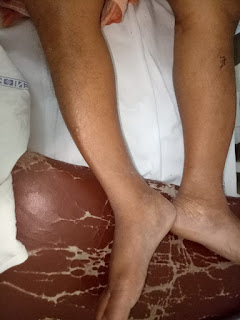CASE 1
https://swathibogari158.blogspot.com/2020/09/chronic-decompensated-liver-disease.html
Q1 Reason for this patients ascites
a)Chronic alcoholism since 40 years causes portal hypertension increased hydrostatic pressure causing fluid accumulation hence Ascites
2) Why did the patient develop bipedal lymphedema? What was the reason for the recurrent blebs and ulcerations and cellulitis in his lower limbs?
Ans: Bilateral pedal oedema which is of pitting type is due to decrease in the albumin level trends due to course of the disease and long standing cirrhosis causing decrease in the production of proteins causing decrease in the oncotic pressure leading to accumulation of fluid.
3) What was the reason for his asterixis and constructional apraxia and what was done by the treating team to address that?
A3 The increased levels of ammonia in liver failure patients causes damage to the neurons causing hepatic encephalopathy the reason for asterixis in this patient
The treatment given is lactulose so that it excretes ammonia
4) What was the efficacy of each treatment intervention used for this patient? Identify the over and under diagnosis and over and under treatment issues in the management of this patient.
Ans: Air or water bed to prevent pressure bed sores in the dependent areas
2. Fluid restriction <1.5litres/day so as to decrease of fluid dissemination into the extra vascular space
Salt restriction <2.4gms/day to prevent retention of water due to osmotic gradient as sodium causes retention
3. Inj augmentin 1.2gm IV/BD to prevent secondary bacterial infections
4. Inj pan 40 mg IV/OD
5. Inj zofer 4mg IV/BD
6. Tab lasilactone (20/50)mg BD ( combination of furosemide and aldactone to decrease pedal oedema
If SBP <90mmhg - to avoid excessive loss of fluid
7. Inj vit k 10mg IM/ STAT ( as vitamin K causes coagulation to further prevent bleeding manifestions
8. Syp lactulose 15ml/PO/BD for hepatic encephalopathy
9. Tab udiliv 300mg/PO/BD contain ursodeoxycholic acid used to dissolve gallstones
10.syp hepameiz 15 ml/PO/OD - It is used for protecting the liver from harmful chemicals or free radicals. L-ornithine- L-aspartate (LOLA), the salt of the natural amino acids ornithine and aspartate acts through the mechanism of substrate activation to detoxify ammonia.
11.IVF 1 NS slowly at 30ml/hr to maintain hydration
12. Inj thiamine 100mg in 100mlNS /IV/TID as thiamine deficiency's occur in chronic alcoholics
13.strict BP/PR/TEMP/Spo2 CHARTING HOURLY
14.strict I/O charting
15.GRBS 6th hourly
16.protein x powder in glass of milk TID for protein supplementation and muscle wasting which commonly occurs in cirrhosis patients
17. 2FFP and 1PRBC transfusion to support coagulation pathways
18 .ASD DONE for wound infections and ulcer
19. High protein diet (2eggs / day) for decreased albumin synthesis
CASE 2
https://sainiharika469.blogspot.com/2020/09/hello-everyone.html?m=1
1) Why were his antitubercular therapy stopped soon after his current admission? Was he symptomatic for ATT induced hepatitis? Was the method planned for restarting antitubercular therapy after a gap of few days appropriate? What evidence is this approach supported by?
Ans. ATT was stopped because his LFT was deranged, Total Bilirubin raised and ALP was also raised. His Serum Albumin was low.
2) What were the investigational findings confirming the diagnosis of pulmonary TB in this man?
Ans. Bilateral infiltration of lung fields noted in chest X-Ray (PA view)
3) What was the cause of his ascites?
Ans. (?) Portal Hypertension.
4) What are the efficacy of each intervention mentioned in his treatment plan and identify the over and under diagnosis as well as over and under treatment issues in it.
Ans.
A. Inj Human Actrapid Insulin s/c 8am - 2pm - 8pm for diabetic management
B. Inj PAN 40 mg IV/OD
C. Inj optineuron 1 amp in 100 ml NS Iv/bd for nutritional supplementation such as Vit B12
D. ATT to be with held for hepatoxicity although should be used based on CTP score mentioned above
E. Syp lactulose 15ml HS to prevent hepatic encephalopathy
F. Protein powder 3 to 4 scoops in 1 glass of milk or water QID for protein supplementation
G. Stop all OHA s
H. Grbs charting 6th hrly
I. Strict I/0 charting
J. High protein diet 4eggs daily for protein supplementation
K. ORS sachets in 1 litre of water to compensate electrolytes lost due to diarrhoea
L. Bp charting hourly
M. Inj PIPTAZ 4.5gm/IV/bd stat - - --> TID
N. Vit k 10 mg Iv OD for 5 days to prevent forthcoming ?bleeding manifestations
O. Temp BP PR monitoring 4th hourly
P. IVF - 1 DNS @50ml/hr for hydration
Q. Nebulisation with salbutamol and mucomist 12th hourly. for ?cough
R. Inj thiamine 100 mg in 100 ml NS IV TID. for chronic
47 year old man with bipedal edema since one year and abdominal distension since one month
1) What will be your further approach toward managing this patient of nephrotic syndrome? How will you establish the cause for his nephrotic syndrome?
Ans.
A. The causes may be - FSGS, Membranous Glomerulonephropathy, Minimal change disease, DM, SLE, Amyloidosis, Cancer, Drugs like
NSAIDS etc.
B. Identifying complications like thromboembolism, infections and renal failure.
C. Managing symptoms like protein loss, pedal oedema and hypercoagulable state.
2) What are the pros and cons of getting a renal biopsy for him? Will it really meet his actual requirements that can put him on the road to recovery?
Ans.
Pros-
A. Renal biopsy would be helpful in establishing cause for glomerular pathology.
Cons-
A.Time and expenditure
B.Post Biopsy complications


Comments
Post a Comment